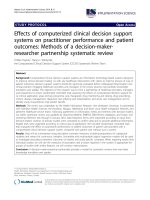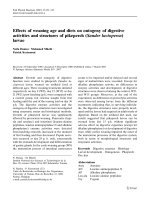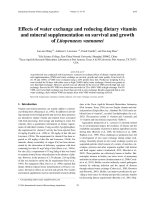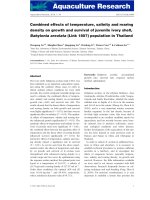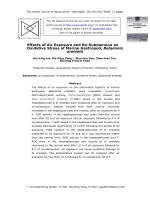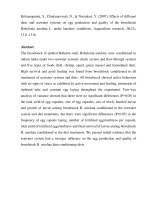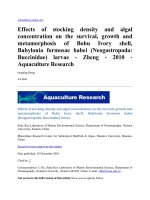Effects of thermal stress and dietary zinc on growth performance, superoxide dismutase–1 and catalase enzyme activity in Pangasianodon hypophthalmus
Bạn đang xem bản rút gọn của tài liệu. Xem và tải ngay bản đầy đủ của tài liệu tại đây (447.64 KB, 12 trang )
Int.J.Curr.Microbiol.App.Sci (2017) 6(6): 2099-2111
International Journal of Current Microbiology and Applied Sciences
ISSN: 2319-7706 Volume 6 Number 6 (2017) pp. 2099-2111
Journal homepage:
Original Research Article
/>
Effects of Thermal Stress and Dietary Zinc on Growth Performance,
Superoxide Dismutase–1 and Catalase Enzyme Activity in
Pangasianodon hypophthalmus
Sachin Kumar*, P. P. Srivastava, Amit Ranjan, T. Jyotismita,
Nishant Kumar Dubey, Sarvendra Kumar and Smital Dilip Kamble
ICAR-Central Institute of Fisheries Education, Mumbai-400061, India
*Corresponding author
ABSTRACT
Keywords
Enzyme,
Pangasianodon
hypophthlmus,
Stress
Article Info
Accepted:
26 May 2017
Available Online:
10 June 2017
A 60-day feeding trail was conducted to determine the effect of dietary zinc level and
temperature on growth and antioxidant enzyme in Pangasianodon hypophthalmus. The six
distinct treatment groups were fed with diets prepared with different zinc levels (16, 32
and 48 mg/kg respectively) in two temperature like 34˚C and ambient temperature. After
60 days experimental trial, the growth parameters like percent weight gain, FCR, PER,
SGR and enzymes Superoxide Dismutase–I and Catalase were studied. In T3 group
inclusion level of 48 mg/kg of zinc with 34˚C showed maximum SGR compared to other
groups. The feed conversion ratios of different experimental groups were showed
significant difference (p<0.05). The lowest (1.45±0.11) FCR was recorded in T3 group.
The highest FCR was found in T5 (2.20±0.11) group. The highest PER value was recorded
in T3 (2.32±0.04) group. The lowest PER was recorded in T5 (1.48±0.13). The value of
the PER and SGR was found in same trend as specific growth and the correlation for each
other. In the present study the SOD activity was significantly higher in group T3 (p<0.05)
compared to the other groups in muscle. From the present work it can be said that dietary
inclusion of zinc had better impact on growth at the two studied temperature, so the 48
mg/Kg zinc can be recommended for the inclusion in diet of Pangasianodon
hypophthalmus at both ambient and 34˚C temperature.
Introduction
Catfishes are the favourite candidate species
for aquaculture in India owing to their
consumer preference, commercial and
medicinal value (Auddy et al., 1994). Culture
practices of Clarias batrachus and
Heteropneustes fossilis have been popularized
widely. Studies on thermal tolerance of
catfishes native to India are reported for H.
fossilis (Vasal and Sundararaj, 1978) and
Pangasius pangasius (Debnathet al., 2006).
However, expansion of aquaculture, by
introducing new fish species is gaining
incentive due to the wide agro-climatic
conditions of India and to keep leap with the
mounting demand for fish protein.
Pangasianodon hypophthalmus (Sauvage,
1878) commonly known as Pangasius, has
achieved impressive success as a commercial
aquaculture species. Zinc is one of the most
important trace elements involved in animal
growth, because it is the most widely used
metal co-factor of enzymes involved in
2099
Int.J.Curr.Microbiol.App.Sci (2017) 6(6): 2099-2111
protein, nucleic acid, carbohydrate and lipid
metabolism as well as control of gene
transcription and other fundamental biological
processes. A dietary input is vital at least in
fresh water fish and the requirement levels are
between 15 to 30 mg/kg. The zinc
requirement has been estimated at 15-30
mg/kg feed for rainbow trout, Oncorhynchus
mykiss (Ogino and Yang, 1978) and 37-57
mg/kg feed for Atlantic salmon, Salmo salar
(Maage and Julshamn, 1993; Maage et al.,
2001). Shim and Lee (1993) reported that zinc
deficient diet causes poor growth rate, low
feed efficiency and high mortality in guppy.
Zinc (Zn) has significant roles in the organism
for growth and protein metabolism, energy
production, gene regulation, maintaining the
health of cell membranes and bones probably
because it is a cofactor of over 200 enzymes
such as alkaline phosphatase, alcohol
dehydrogenase and carbonic anhydrase etc.
(Watanabe et al., 1997; Yamaguchi, 1998).
One of the most significant functions of zinc
is related to its antioxidant role and its
participation in the antioxidant defence
system (Powell, 2000). Zinc deficiency shows
growth retardation, cataract, skin erosion, and
higher mortality, oxidative damage through
the effects of free radical activity (Ogino and
Yang, 1978; Powell et al., 1994; Salgueiro et
al., 2000) and changes the status of
antioxidant enzymes and substances (Prasad
et al., 1993). The process by which Zn exerts
its antioxidant activity is not well specified.
Nevertheless, it has been proposed that it
increases the synthesis of metallothionein, a
cysteine-rich protein, which plays as an
important role to act as free radical scavenger
(Prasad et al., 1993; Bales et al., 1994). Zinc
deficiency increases oxidative damage due to
free radical activity (Powell et al., 1994;
Salgueiro et al., 2000). In animals, aerobic
tissues continuously generate superoxide
radicals (O2.−) and hydrogen peroxide (H2O2)
at the mitochondrial and endoplasmic
reticulum membranes as by-products of the
oxidative
metabolism.
The
primary
antioxidant protection against these species is
provided by the enzymes superoxide
dismutase (SOD) and catalase (CAT),
respectively (Chance et al., 1979).
Consequently, these antioxidant enzymes
contribute to the maintenance of a relatively
low level of the reactive and harmful species
hydroxyl radical (̇̇̇̇̇̇OH), which is generated
through the Haber–Weiss reaction between
(O2̇̇̇ −) and H2O2 in the presence of Cu2+ and/or
Fe3+. Brian and co-worker (2001) reported
that the variable thermal environment can
induce thermal stresses to aquatic animals and
potentially affects the enzyme activity and
antioxidant defence system in aquatic
organisms (Abele et al., 1998; Portner, 2002).
Higher temperature is reported to increase
reactive oxygen species release and enhances
the risk of oxidative damage (Abele et al.,
1998). Most living systems adapt to oxidative
stress by increasing their antioxidant potential
which seems to be the most important
effective protection against oxidative stress
(Hermes-Lima, 2004). Increased availability
of anti-oxidative enzymes like superoxide
dismutase and catalase is believed to
minimize oxidative stress (Portner, 2002).
They directly detoxify harmful reactive
oxygen species and oxidative damage to
cellular components. Akther et al., (2013)
reported SOD and catalase activities in liver,
gill and kidney tissues of T. putitora were
significantly higher at higher acclimation
temperatures which are a clear indication of
higher magnitude of oxidative stress in these
groups.
Realizing the importance of dietary Zinc the
present study was conducted with the
objective to examine the effects of thermal
Stress and Dietary Zinc on growth
performance, Superoxide Dismutase–I and
Catalase enzyme activity in Pangasianodon
hypophthalmus.
2100
Int.J.Curr.Microbiol.App.Sci (2017) 6(6): 2099-2111
Materials and Methods
Feeding
The experiment was conducted at the wet
laboratory of ICAR- Central Institute of
Fisheries Education (CIFE), Mumbai. The
fishes were procured from Kolkata (W.B).
The fishes were transported in the well
aerated syntax tanks. They were carefully
transferred to a circular tank (1000 L).
Feeding was initially done @ 3% of the body
weight and the feeding rate was adjusted
accordingly. The daily ration was divided into
two equal parts and was fed at 8.00 am in the
morning and 5.00 pm in the evening.
The experiment was conducted for a period of
60 days in the wet laboratory of old campus,
CIFE, Mumbai. The setup consisted of 18
plastic rectangular tubs (80 X 57 X 42 cm,
150 L capacity) covered with perforated lids.
Animals used for the experiment were
advanced fingerlings of Pangasianodon
hypophthalmus (Sauvage, 1822) with an
initial weight ranging from 5.32 to 5.70 g.
Two hundred thirty four (234) fishes were
randomly distributed in 18 distinct
experimental groups in triplicates, following a
completely randomized design.
Sampling for growth was done at every 15
days to assess the body weight of the fishes.
Fishes were starved overnight before taking
the weight. The growth performance was
assessed by using the following formula:
Water quality parameters viz. temperature,
pH, dissolved oxygen, free carbon dioxide,
total hardness, ammonia, nitrite and nitrate
were recorded during the experimental period.
Specific growth rate (SGR)
Formulation
and
experimental diets
preparation
Growth parameters
Percentage weight gain
The percentage weight gain was calculated
using the following formula
The specific growth rate was calculated by the
following formula
of
Purified ingredients such as casein (vitamin
free), gelatin, dextrin, starch, cellulose,
carboxymethylcellulose
(CMC),
betainehydrochloride,
butylated
hydroxytoluene (BHT), cod liver oil,
sunflower oil and vitamin-mineral mixture
(zinc free) were taken for feed formulation
(Table 1). Three diets with the same
composition were prepared which contained
zinc acetate in different concentrations. The
diets were T1 (53.7 mg Zn acetate/kg =16 mg
Zn/kg), T2 (107.4 mg Zn acetate/kg =32 mg
Zn/kg) and T3 (161.2 mg Zn acetate/kg = 48
mg Zn/kg).
Feed conversion ratio (FCR)
The feed conversion ratio was calculated by
the following formula
Protein efficiency ratio (PER)
Protein efficiency ratio was calculated by the
following formula
2101
Int.J.Curr.Microbiol.App.Sci (2017) 6(6): 2099-2111
Survival rate
At the end of the experiment, all the
experimental tubs were dewatered and the
number of the experimental animals in each
tub was counted and the survival rate (%) was
calculated by the following formula.
Enzyme assays
At the end of the experiment fishes were
collected from each tank ((T1, T2, T3, T4, T5
and T6) and anaesthetized with clove oil (50
μl.L-1). Fishes were then dissected and the
tissues viz., liver, gills, and muscle, were
immediately removed. A 5% tissue
homogenate was prepared in chilled 0.25 M
sucrose solution by Teflon coated mechanical
homogenizer (REMI Equipment, Mumbai,
India). The whole procedure was followed in
ice cold condition. Homogenized samples
were centrifuged at 8000 rpm for 10 min at
4˚C. The supernatant was collected in glass
vials and stored in deep freezer (-200C) for
enzyme assay. Suitable dilution of the
samples was done as and when required.
Quantification of protein of the different
tissues was carried out by using Bradford
method (Bradford, 1976). The Bradford assay
relies on the binding of the dye Coomassie
blue G250 to protein.
Tissue homogenate (20 μl) was taken along
with 180 μl distilled water and 250 μl 1N
NaOH added. After that 5 ml Bradford
reagent added and kept for 5 mins. Reading
was taken at 595 nm against the blank.
Protein content was expressed in mg/g wet
tissue.
Superoxide dismutase was assayed according
to the method described by Mishra and
Fridovich (1972) based on the oxidation of
epinepherine-adrenochrome transition by the
enzyme. Fifty microlitre of the sample was
taken in the cuvette and 1.5 ml 0.1M
carbonate–bicarbonate buffer containing 57
mg/dl EDTA (pH 10.2) and 0.5 ml
epinephrine (0.3 mM) was added and mixed
well. Change in optical density at 480 nm was
read immediately for 3 min in a Shimadzu–
UV spectrophotometer. One unit of SOD
activity was the amount of protein required to
give 50% inhibition of epinephrine autooxidation. SOD expressed as unit activity
(amount of protein required to give 50%
inhibition of epinephrine auto-oxidation).
Catalase was assayed according to the method
described by Takahara et al., (1960). To a
reaction mixture of 2.45 ml phosphate buffer
(50 mM, pH 7.0), enzyme source was added
and the reaction was started by the addition of
1.0 ml of H2O2 solution. The decrease in
absorbance was measured at 240 nm at 15 sec
intervals for 3 min. The enzyme blank was
run simultaneously with 1.0 ml distilled water
instead of H2O2 solution. Enzyme activity was
expressed as nano moles H2O2 decomposed
/min /mg protein
Proximate analysis of the experimental
diets and carcass tissue
Proximate analysis of the diets and carcass
tissue was done by standard methods (AOAC,
1995) at Fish Nutrition Laboratory, CIFE.
The moisture content of the experimental
diets and carcass tissue was determined by
taking a known weight of the sample in the
petri dish and drying it in a hot air oven at
1050C till a constant weight was achieved.
Nitrogen content of the experimental diets
and carcass tissue dried samples were
estimated quantitatively by Kjeltec semiautomated system (2200 Kjeltec Auto
2102
Int.J.Curr.Microbiol.App.Sci (2017) 6(6): 2099-2111
Distillation, Foss Tecator, and Sweden) using
titration as the means for determining
nitrogen percentage. The crude protein
percentage was obtained by multiplying the
nitrogen percentage by a factor of 6.25.Ether
extract of dried experimental diets and carcass
tissue samples were estimated by Soxhlet
apparatus using petroleum ether (boiling point
40-60 0C) as the solvent. Ash content of the
experimental diets and carcass tissue was
estimated by taking a known weight of dried
samples in a silica crucible and placing it in a
muffle furnace at 550˚C for 6 hours.
Digestible energy of the experimental diets
was calculated following Halver (1976)
formula:
Digestible energy (kcal/100 g) =protein (%) x
4 + lipid (%) x 9 + carbohydrate (%) x4
Statistical analysis
Statistical significance of different enzyme
activities was analysed using two-way
analysis of variance (ANOVA) via SPSS 22.0
for Windows. Duncan’s multiple range test
was used for post hoc comparison of mean
(P<0.05) between different acclimation
temperatures. All data presented in the text,
figures and tables are means ± standard error
and statistical significance for all statistical
tests was set at P<0.05.
Results and Discussion
Proximate composition of feed
In the present study, dietary zinc
supplemented based diets were maintained
with a specific range of moisture content, dry
matter, crude protein and ether extract were
found to be in 10.51±0.19 to 11.15±0.06%,
88.85±0.06 to 89.49±0.19%, 34.35±0.68 to
35.7±0.10% and 7.02±0.20 to 8.01±0.40%
respectively.
The
calculated
average
digestible energy was 406.41 kcal/100 gm
feed. Above range of nutrients were as
described by several authors. Phumee et al.,
(2009) suggested that optimum protein and
lipid
requirement
of
Pangasianodon
hypophthalmus ranges between 30-35% and
8-12% respectively. The digestible energy
content of experimental diets was found to be
within the range of 368.68-375.09 kcal/100 g
in a study by Rostagno et al., (2000).
Physico-chemical parameters of water
The physico-chemical parameters of water
such as temperature (˚C), pH, dissolved
oxygen (mg.L-1), free carbon dioxide (mg.L1
), total hardness (mg.L-1), ammonia (mg.L-1),
Nitrite-N (mg.L-1), Nitrate-N (mg.L-1), Zinc
level (mg.L-1) are presented in table 2. All the
physico-chemical parameters of water such as
temperature, pH, dissolved oxygen, free
carbon dioxide, carbonate hardness, ammonia,
nitrite- N, nitrate-N were observed to be
within the optimum range of requirements for
fish. Temperature plays an important role in
regulating the metabolism of animals, so an
optimum range of temperature is required for
optimum metabolic activity, which in turn
gives maximum yield so we designed one
ambient temperature and 34˚C. Since
Pangasianodon hypophthalmus can thrive
well at temperature range of 20-35˚C
(Choudhury, 2000). It supported the range of
temperature from 34.05˚C to 34.22˚C during
the experimental period. The pH of water in
all the experimental groups were ranged from
7.5-8.4, which is within the acceptable range
(6.7-8.6) as suggested by Andrew et al.,
(1972) and 6.5-9.0 as suggested by Swingle
(1967). The dissolved oxygen level in water
was varied with a large number of factors
such as water temperature, metabolic rate,
biomass density, aeration etc. The dissolved
oxygen level in different experimental tubs
was recorded to be within the range of 4.8-7.3
mg.L-1 which is within the optimum range of
5.0-8.0 mg.L-1 for Thai pangus as suggested
2103
Int.J.Curr.Microbiol.App.Sci (2017) 6(6): 2099-2111
by Sarker (2000). It is assumed that dissolved
oxygen was optimum throughout the
experimental period, which is due to continue
aeration. In the present study, the carbon
dioxide concentration was found to be
negligible, and hence did not have any
adverse effect on the survival and
performance of the experimental animals.
This may be due to low biomass and daily
water exchange during the experimental
period. The carbonate hardness was found to
be 230-253 mg.L-1 during the experimental
period.
Growth parameters
In the present study, the different zinc level
supplemented diets were showed significant
effect on weight gain percentage. In T3 group
Inclusion level of 48 mg/kg of zinc with 34˚C
showed maximum SGR compared to T5 (Zn
48 mg/kg with ambient temperature) as well
as the other group. This may be correlated
with the fact that 48 mg/kg supplemented zinc
with 34˚C were better utilized by
Pangasianodon hypophthalmus while the
lower inclusion level reflected the reduced
growth. The lowest weight gain percentage
and SGR were found in T4 group and growth
improvements observed in the dietary zinc
supplemented at levels of 32 mg/kg, and
maximum in 48 mg/kg supplemented.
However, growth retardation has been
encountered in T4 (16 mg/kg) group. Which
is comparatively high temperature exposed
group and it clearly reflects that at the
elevated level of temperature there is reduced
growth which may be either due to elevated
dietary requirement of zinc or high rate of
metabolism at higher temperate while the
substantial increase of the growth at the group
T6 Indicates positive effect of the dietary zinc
at high temperature as well determining the
dietary requirement is optimum at higher
level of inclusion. It also clearly indicates that
decreasing level of zinc negatively effect on
growth at ambient temperature and elevated
temperature. Dietary zinc supplemented diet
(48 mg/kg) can be considered as adequate
level of zinc, which had significant effect on
growth at ambient temperature and elevated
temperature. Since the highest growth has
been found in highest inclusion of dietary zinc
so the further study is required in this area for
exploring the maximum inclusion level at
ambient and elevated temperature. Similarly,
Ogino and Yong (1978) reported that zinc
deficiency induced retarded growth and high
mortality in common carp at ambient
temperature. The feed conversion ratios of
different experimental groups were showed
significant difference. The FCR of different
experimental groups were varied significantly
(p<0.05). The lowest (1.45a±0.11) FCR was
recorded in T3 group. The highest FCR was
found in T5 (2.20bc±0.11) group. While the
T4 group, lowest level of supplementation at
16 mg/kg level and ambient temperature has
no significant difference with T5 group i.e. 32
mg/kg with ambient temperature. The mean
per value was significantly different (p<0.05)
among the different treatment groups. The
highest PER value was recorded in T3
(2.32d±0.04) group. The lowest PER was
recorded in T5 (1.48a±0.13). The value of
SGR were varied significantly (p<0.05)
among different treatment groups. The lowest
SGR value was found in T4 (1.55a±0.02)
group and higher SGR was found in T3 group
(2.00±0.04). The value of the PER and SGR
was found in same trend as specific growth
and the correlation holds the support for each
other. This result is supported by Eid et al.,
(1993) reported that zinc deficient diet
showed higher FCR and lower growth rate in
Oreochromis niloticus. So, the present study
indicated that dietary zinc supplementation up
to 48 mg/kg diet with 34˚C has direct
influence on FCR of Pangasianodon
hypophthalmus. There was no mortality
observed during the experimental period
(Table 3).
2104
Int.J.Curr.Microbiol.App.Sci (2017) 6(6): 2099-2111
Table.1 Composition of purified experimental diets
Ingredients
Casein purified
Starch
Dextrin
Cellulose
CMC
Gelatine
Oil
BHT
Zn-acetate g/100g
VM+MM(Zn deficient)
Total
T1
(Low level Zinc)
35.00
24.00
7.00
14.87
4.00
3.00
10.10
0.02
0.0054
2
100
T2
(Medium level Zinc)
35.00
24.00
7.00
14.87
4.00
3.00
10.10
0.02
0.0107
2
100
T3
(High level zinc)
35.00
24.00
7.00
14.87
4.00
3.00
10.10
0.02
0.00161
2
100
Composition of vitamin mineral mix (quantity/250g starch powder) : Vitamin A-55,00,00 IU; Vitamin D3-11,00,00
IU; Vitamin B1-20mg; VitaminB2-200mg; Vitamin E-75mg; VitaminK-100mg; VitaminB12-0.6mcg; Calcium
pantothenate-250mg; Nicotinamide-1000mg; Pyridoxine-100mg; Mn-2700mg; I-100mg; Fe-750mg; Choline
chloride-500mg; Cu-200mg; Co- 45mg; Ca-50g; P-30g; Se-0.5ppm
Table.2 Physico-chemical parameters of water during the experimental period of
60 days for different experimental groups
Parameter
T1
T2
T3
T4
T5
T6
4.8-7.4
4.8-7.3
4.8-7.3
6.2-7.3
6.2-7.3
6.2-7.3
Temperature (˚C)
33.8-34.3
33.9-34.1
33.6-34.4
27.3-28.7
27.6-28.2
pH
Hardness (mg.L-1)
Ammonia (mg.L-1)
7.6-8.2
227-236
7.7-8.3
238-240
0.22-0.26
7.5-8.1
238-242
0.21-0.24
7.8-8.6
238-240
0.21-0.23
0.001-0.002
0.001-0.002
0.001-0.002
Dissolved
oxygen(mg.L-1)
Nitrite(mg.L-1)
26.8-28.8
7.6-8.4
7.7-8.2
0.13-0.20
239-246
0.14-0.20
229-243
0.13-0.20
0.001-0.002
0.001-0.002
0.001-0.002
Table.3 Growth parameters of the different experimental groups fed different
Experimental diets at the end of the experiment
Treatments
T1
T2
T3
T4
T5
T6
Weight Gain%
193.22b±3.49
173.37ab±5.09
235.69d±8.48
162.34a±5.78
156.21a±7.47
184.78b±8.44
SGR
1.77c±0.080
1.68a±0.04
2.00d±0.04
1.59a±0.05
1.55a±0.02
1.73b±0.02
FCR
1.85b±0.11
1.88bc±0.14
1.45a±0.11
2.16bc±0.09
2.20c±0.06
1.85b±0.06
PER
1.86b±0.07
1.74ab±0.06
2.32d±0.04
1.58ab±0.08
1.48a±0.13
1.77b±0.07
Data expressed as Mean ± SE, n=3.The different treatments were found to be significantly different (p<0.05) from
each other
2105
Int.J.Curr.Microbiol.App.Sci (2017) 6(6): 2099-2111
Table.4 Proximate composition of the fish carcass
Treatments
Moisture (%)
T1
T2
T3
T4
T5
T6
73.78±0.650
73.46±0.16
72.50±0.70
73.04±0.24
74.39±0.40
73.86±0.23
Crude Protein
(%)
15.85±0.51
16.61±0.38
16.21±0.40
16.09±0.46
15.81±0.72
15.89±0.55
Ether Extract
(%)
7.35±0.55
7.11±0.11
7.98±0.45
7.52±0.02
7.66±0.04
7.22±0.42
Ash (%)
1.74±0.08
1.71±0.01
1.88±0.01
1.97±0.005
1.69±0.035
1.79±0.03
Data expressed as Mean ± SE, n=3.The different treatments were found to be significantly different (p<0.05) from
each other.
Fig.1 SOD-1 activity in muscle of Pangasianodon hypophthalmus fingerlings
Fed with different experimental diets
Fig.2 SOD-1 activity in gill of Pangasianodon hypophthalmus fingerlings
Fed with different experimental diets
2106
Int.J.Curr.Microbiol.App.Sci (2017) 6(6): 2099-2111
Fig.3 Catalase activity in liver of Pangasianodon hypophthalmus fingerlings
Fed with different experimental diets
Fig.4 Catalase activity in gill of Pangasianodon hypophthalmus fingerlings
Fed with different experimental diets
SOD-1 and catalase enzyme activity
The enzymes of antioxidant defence viz.
SOD-1 and Catalase are presented in figures
1, 2, 3 and 4 respectively. The antioxidant
defences are very important in maintaining
the homeostasis and overcome by pro-oxidant
forces and reactive oxygen species play
important role in it (Sies et al., 1992). Living
organisms are protected from the ROS by
several defence mechanisms, including
antioxidant enzymes such as SOD and
catalase. In the present study, the SOD
activity was significantly higher in group T3
(p<0.05) compared to the other groups in
muscle which may be due to the interactive
impact of the highest dietary inclusion of the
zinc and temperature. While SOD activity
was not significantly different among the
different experimental groups in gill. Higher
2107
Int.J.Curr.Microbiol.App.Sci (2017) 6(6): 2099-2111
temperature is reported to increase reactive
oxygen species (Abele et al., 1998). Most
living systems adapt to oxidative stress by
increasing their antioxidant potential which
seems to be the most important effective
protection against oxidative stress (HermesLima, 2004). Increased availability of antioxidative enzymes like superoxide dismutase
to minimize oxidative stress (Portner, 2002)
and increase the animal competence of effect
of temperature and higher bioavailability of
zinc at higher temperature (Phillips, 1978),
this indicates that the free radicals are
effectively scavenged by the SOD-1.
Metabolism is also dependent on acclimation
temperature, acclimation period and species
(Das et al., 2004; Manush et al., 2004). The
role of Zn (II) in Cu-Zn SODs is structural
rather than functional. Replacement of Zn (II)
with Co (II), Hg (II), Cd (II) or Cu (II) does
not affect activity (Cudd and Fridovich, 1982,
Bordo et al., 1994; Marino et al., 1995). Even
a complete removal of Zn (II) from the
protein has little effect on activity. Zn (II)
probably confers structural stability to the
active site (Bordo et al., 1994, Marino et al.,
1995). However, it was found that, in the
muscle, the SOD activity in the 34˚C
temperature with Zn interaction in
experimental groups was significantly
different (p<0.05).
Catalase is another major primary antioxidant
defence component that works primarily to
catalyse the decomposition of H2O2 to H2O,
sharing this function with glutathione
peroxidase (GPX). Whereas the catalase
activity of the liver and gill tissues in 60 day
periods was determined. There was a
significant difference (p<0.05) in the enzyme
activity of the different treatment groups in
the liver. In the liver, the least catalase
activity was found in the T3 group whereas
the highest enzyme activity was found in the
T6 whereas no significant difference was
followed in the gill but the least activity was
in the T2 group and highest in T4. As the
optimum temperature for the pangasius lies to
be in 30 to 35˚ C (Debnathet al., 2006). The
increase in the antioxidant enzymes at higher
or lower side of the optimum temperature has
been shown to increase catalase activity due
to oxidative stress at suboptimal temperature
especially in gill. In a similar report by
Madeira (2013) oxidative stress response was
not directly correlated to temperature. It was
lowest at the optimal temperature (24˚C) and
it increased in European sea bass,
Dicentrarchus labrax outside the upper and
lower optimum thermal limits. It was
concluded that, although these biomarkers
have been used mostly as indicators of the
effects of contamination in field studies, they
are very sensitive to temperature either higher
or lower side of the thermal optimal range.
Biochemical composition of the fish carcass
Data relating to the biochemical composition
of all the experimental animals in terms of
moisture, protein, lipid and ash at the end of
the experiment reflect no significant variation
(P>0.05). The moisture content of all the
experimental fish sampled for proximate
analysis varied from 72.50 to 74%. The crude
protein content (wet weight basis) varied from
15.81 to 16.61%. The ether extract of all the
fish was estimated within 7.11 to 7.98%.The
total ash content varied from 1.69 to 1.97%.
The proximate composition of the fish tissues
is shown in table 4.
Catfishes are the preferred candidate species
for aquaculture in India owing to their
consumer preference, commercial and
medicinal value. In the present study, the
maximum
growth
in
Pangasianodon
hypophthalmus fingerlings has been achieved
at dietary zinc supplementation of 48 mg/kg
with 34˚C. Therefore, in conclusive way it
can be said that the 48 mg/kg of dietary
inclusion of zinc is required for the
2108
Int.J.Curr.Microbiol.App.Sci (2017) 6(6): 2099-2111
Pangasianodon hypophthalmus optimum
growth at elevated temperature in optimum
range. Since, the highest dietary inclusion of
zinc had given better result at ambient and
34˚C temperature.
References
Abele, D., Burlando, B., Viarengo, A. and
Portner, H. O., 1998. Exposure to
elevated temperatures and hydrogen
peroxide elicits oxidative stress and
antioxidant response in the Antarctic
intertidal limpet Nacellaconcinna. Comp.
Biochem. Physiol.B, 120: 425–435
Akhtar, M. S., Pal, A. K., Sahu, N. P., Ciji, A.
and Mahanta, P. C., 2013. Thermal
tolerance, oxygen consumption and
haemato-biochemical variables of Tor.
Putitora juveniles acclimated to five
temperatures. Fish. Physiol. Biochem.,
39: 1387-1398.
Andrews, J. W., Knight, L. H., Page, J. W.,
Matsuda, Y. and Brown, E. E., 1972.
Aquacult. Soc., 29(3):281-287
Auddy, B., Alam, M. I., Gomes, A., 1994.
Pharmacological actions of the venom of
the Indian catfish (Plotosus canius
Hamilton). Ind. J. Med. Res., 99: 47–51.
Bales, C.W., Di, Silvestro, R.A., Currie, K.L.,
Plaisted, C.S., Joung, H., Galanos, A.N.
and Lin, P.H., 1994. Marginal zinc
deficiency in older adults: responsiveness
of zinc status indicators. J. Am. Coll.
Nutr. 13: 455-462.
Bordo, D., Djinovic, K. and Bolognesi, M.,
1994. Conserved patterns in the Cu-Zn
superoxide dismutase family. J. Mol.
Biol., 238: 366-386.
Bradford, M. M., 1976. A rapid and sensitive
method for the quantitation of microgram
quantities of protein utilizing the principle
of protein-dye binding. Analytical
Biochemistry, 72: 248-254
Brian, S., Helmuth, T. and Hofmann, G. E.,
2001.
Microhabitats,
thermal
heterogeneity,
and
patterns
of
physiological stress in the rocky intertidal
zone. Biol. Bull., 201: 374–384.
Chance, B., H, Sies., A., Boveris, A., 1979.
Hydroperoxide
metabolism
in
mammalian organs. Physiol. Rev. 59:
527-602.
Choudhury, H. A., 2000. Polyculture System of
Thai Pangus at Alpha Fisheries.
Cudd, A. and Fridovich, I., 1982. Electrostatic
Interactions in the Reaction Mechanism
of Bovine Erythrocyte Superoxide
Dismutase. J. Biol. Chem., 257: 1144311447.
Das, T., Pal, A. K., Chakraborty, S. K., Manush,
S. M., Chatterjee, N. and Mukherjee,
S.C., 2004. Thermal tolerance and oxygen
consumption of Indian Major Carps
acclimated to four different temperatures.
J. Therm. Biol., 23: 157-163.
Debnath, D., Pal, A. K., Sahu, N. P., Baruah,
K., Yengkokpam, S., Das, T. and
Manush, S. M., 2006. Thermal tolerance
and metabolic activity of yellow tail
catfish pangasius pangasius (hamilton)
advanced fingerlings with emphasis on
their culture potential. Aquaculture, 258:
606-610.
Hermes-Lima, M., 2004. Oxygen in biology and
biochemistry: role of free radicals. In:
Storey KB (ed) Functional Metabolism:
Regulation and Adaptation. Wiley-Liss,
Hoboken, pp. 319–368
Maage, A. and Julshamn, K., 1993. Assessment
of zinc status in juvenile Atlantic salmon,
Salmo salar by measurement of whole
body and tissue levels of zinc.
Aquaculture, 117: 179-191.
Maage, A., Julshamn, K. and Gerd, E. B., 2001,
Zinc gluconate and zinc sulphate as
dietary zinc sources for Atlantic salmon.
Aqua. Nutr, 7:183-187.
Madeira, D., L. Narciso, L., Cabral, H. N.,
Vinagre, C. and Diniz, M. S., 2013.
Influence of temperature in thermal and
oxidative stress responses in estuarine
fish. Comp. Biochem. And Physiol,., 166
A: 237-243.
Manush, S. M, Pal, A. K, Chatterjee, N., Das, T.
and Mukherjee, S. C., 2004. Thermal
tolerance and oxygen consumption of
2109
Int.J.Curr.Microbiol.App.Sci (2017) 6(6): 2099-2111
Macrobrachium rosenbergii acclimated
to three temperatures. J. Therm. Biol., 29:
15–19.
Marino, M., Galvano, M., Cambria, A.,
Polticelli, F. and Desideri, A., 1995.
Modeling the three-dimensional structure
and the electrostatic potential field of two
Cu, Zn superoxide dismutase variants
from tomato leaves. Protein Eng., 8: 551556.
Ogino, C. and Yang, G. Y., 1978. Requirement
of rainbow trout for dietary zinc. Bull.
Jpn. Soc. Sci. Fish., 44: 1015-1018.
Phillips, G. R. and Russo, R. C., 1978. Metal
bioaccumulation in fishes and aquatic
invertebrates: A literature review,
Environmental Protection Agency, Office
of
Research
and
Development,
Environmental Research Laboratory.
Phumee, P., Hashim, R., Aliyu‐ Paiko, M. and
Shu‐ Chien, A. C., 2009. Effects of
dietary protein and lipid content on
growth performance and biological
indices of iridescent shark (Pangasius
hypophthalmus, Sauvage 1878) fry. Aqua.
Res., 40: 456-463.
Portner, H. O., 2002. Climate variations and the
physiological basis of temperature
dependent biogeography: systemic to
molecular hierarchy of thermal tolerance
in animals. Comp. Biochem. Physiol. 132
A: 739–761
Powell, S. R., 2000. The antioxidant properties
of zinc. J. Nutr., 130: 1447S–1454S.
Powell, S. R., Hall, D., Aiuto, L., Wapnir, R.
A., Teichberg, S. and Tortolani, A. J.
(1994). Zinc improves postischemic
recovery of isolated rat hearts through
inhibition of oxidative stress. Am. J.
Physiol., 266: 2497–2507.
Prasad, A. S., Fitzgerald, J. T., Hess, J. W.,
Kaplan, F., Pelen, J. and Dardenne, M.,
1993. Zinc deficiency in elderly patients.
Nutrition, 9:218–224.
Rostagno, H., Pupa, J. and Pack, M. 1995. Diet
formulation for broilers based on total
versus digestible amino acids. J. Appl.
Poult. Res., 4: 293-299.
Salgueiro, M. J., Zubillaga, M., Lysionek, A.,
Sarabia, M. I., Caro, R., De Paoli, T.,
Hager, A., Weill, R. and Boccio, J., 2000.
Zinc as essential micronutrient: a review.
Nutr. Res., 20: 737–755.
Sarker, M. T., 2000. Pangus Chash
Babosthapana (Management of Pangus
culture). Department of Fisheries,
Bangladesh. 25 p.
Sies, H., Stahl, W. and Sundquist, A. R. 1992.
Antioxidant functions of vitamins. Ann.
N. Y. Acad. Sci., 669: 7-20.
Swingle, H. S., 1967. Estimation of standing
crops and rates of feeding fish in ponds.
FAO Fish. Rep., 44:416-423.
Takhara, S., Hamiton, H. B., Neel, J. V.,
Kobara, T. Y., Ogura, Y and Nishimura,
E. T., 1960. Hypoctalasemia, a new
genetic carrier state. J. Clin. Invest, 39:
610-619
Vasal, S. and Sundararaj, I. S., 1978. Thermal
tolerance and preference of the Indian
catfish Heteropneustes fossilis. Environ.
Biol. Fisches, 3: 309–315.
How to cite this article:
Sachin Kumar, P.P. Srivastava, Amit Ranjan, T. Jyotismita, Nishant Kumar Dubey, Sarvendra
Kumar and Smital Dilip Kamble. 2017. Effects of Thermal Stress and Dietary Zinc on Growth
Performance, Superoxide Dismutase–1 and Catalase Enzyme Activity in Pangasianodon
hypophthalmus. Int.J.Curr.Microbiol.App.Sci. 6(6): 2099-2111.
doi: />
2110


